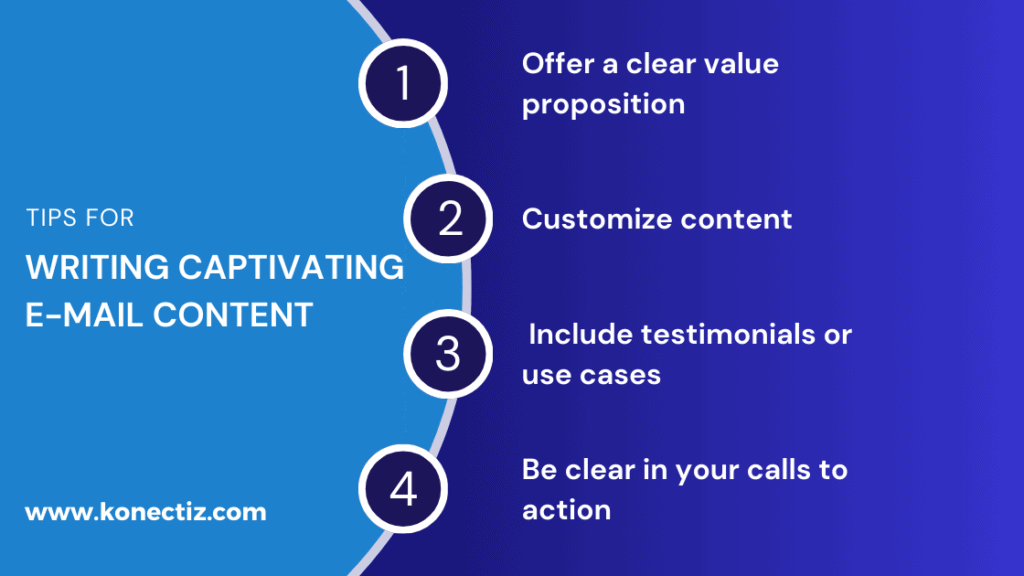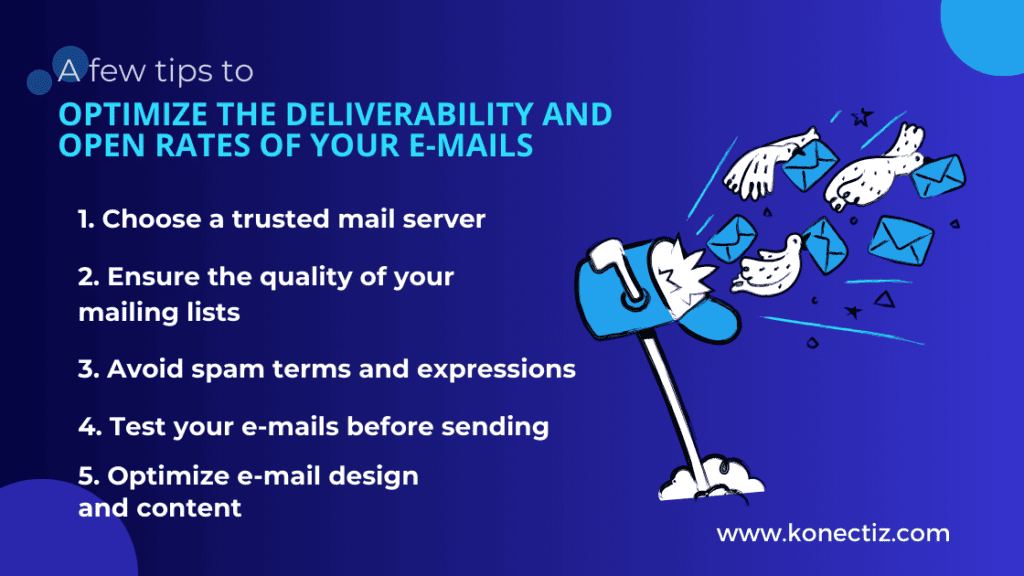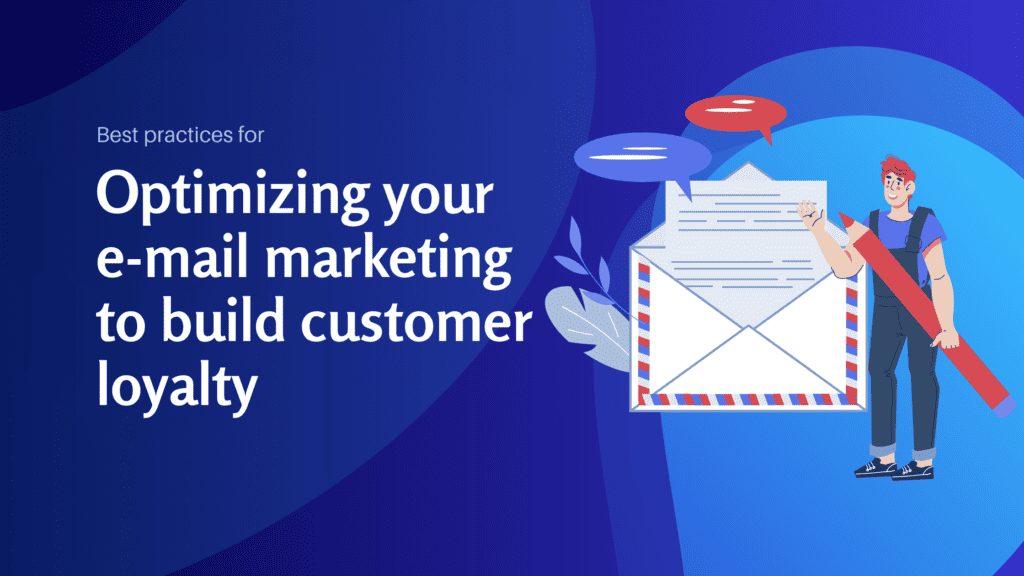Introduction
E-mail marketing is a powerful tool for building customer loyalty and increasing sales. However, to get the most out of them, it’s essential to optimize your e-mail campaigns. In this article, we’ll show you the best practices you can follow to optimize your e-mail marketing and strengthen your customers’ loyalty. One of the keys to a successful e-mail marketing campaign is knowing your target audience. By understanding your customers’ needs and preferences, you can personalize your e-mails to make them relevant and attractive.
What’s more, the user experience is crucial to engaging readers and maintaining their loyalty. Make sure your e-mails are readable on all devices and optimized for easy navigation. Use high-quality images and videos to capture the attention of your recipients.
By following these best practices and optimizing your e-mail marketing, you can create engaging campaigns that build customer loyalty and boost your business. Use these tips to go beyond simple promotional e-mails and offer your customers added value.
The importance of customer loyalty in e-mail marketing
The importance of customer loyalty in e-mail marketing lies in its ability to maintain long-lasting, profitable relationships with existing customers. Indeed, email marketing offers an effective platform for staying in touch with customers, providing them with relevant, personalized information, and encouraging them to stay engaged with the brand over time. By developing a solid loyalty strategy, companies can increase customer retention, boost repeat sales and encourage referrals, all of which contribute to the company’s long-term growth.
Another reason why customer retention is crucial in e-mail marketing is its cost-effectiveness. Unlike acquiring new customers, retaining existing ones is often less costly and more profitable. By using targeted e-mail marketing campaigns to maintain the interest and commitment of existing customers, companies can maximize their return on investment and optimize their marketing resources.
Building customer loyalty via e-mail marketing helps to strengthen trust and brand loyalty. By regularly sending out relevant, value-added communications, companies can build trusting relationships with their customers, encouraging them to remain loyal to the brand and continue to make long-term purchases. This brand loyalty can also lead to an increase in the customer’s share of wallet, where loyal customers are more likely to buy other products or services offered by the company.
Understanding your target audience for effective e-mail marketing
Understanding your target audience is a cornerstone of effective e-mail marketing. This in-depth understanding enables you to create campaigns that really resonate with your recipients. To start with, it’s essential to gather demographic data such as age, gender, geographic location and interests. This information helps you segment your subscriber list into more specific groups, enabling you to send more targeted and relevant messages to each segment. For example, you can personalize your offers according to the age or interests of your subscribers, making them more likely to respond positively to your e-mails.
Next, it’s important to understand the needs and challenges of your target audience. By identifying the problems they face and proposing solutions in your e-mails, you show that you really understand their concerns and are there to help. This reinforces the trust and credibility of your brand, which can lead to higher conversion rates and increased customer loyalty.
Another essential dimension of understanding your target audience is knowing their communication preferences. Some may prefer to receive short, punchy promotional e-mails, while others prefer more detailed and informative ones. By monitoring the open, click and conversion rates of your campaigns, you can determine which approaches work best for different segments of your list, and adjust your strategy accordingly.
Some analysis tools commonly used in e-mail marketing
One way to better understand your target audience is to use analytics tools to track their actions and preferences. Here are some analysis tools commonly used in e-mail marketing, and their uses:
1. Google Analytics
Google Analytics is one of the most powerful and popular analytics tools available. It tracks a variety of metrics related to user behavior on your website, including traffic sources, conversion rates, user journeys, and much more. In e-mail marketing, you can use Google Analytics to track open rates, click-through rates and conversions from your e-mail campaigns.
2. Mailchimp Analytics
Mailchimp is an e-mail marketing platform that also offers advanced analysis tools. With Mailchimp Analytics, you can track the performance of your e-mail campaigns in real time, including open rates, click-through rates, unsubscribes and much more. You can also obtain detailed information on user behavior, enabling you to tailor your campaigns to their preferences.
3. Sendinblue Analytics
Sendinblue is another popular e-mail marketing platform offering comprehensive analysis tools. With Sendinblue Analytics, you can track the performance of your e-mail campaigns, as well as other communication channels such as SMS and social network messages. You can also obtain information on audience engagement, enabling you to optimize your campaigns for better results.
4. HubSpot Analytics
HubSpot is an all-in-one marketing software suite that includes advanced analysis tools. With HubSpot Analytics, you can track the performance of all your marketing activities, including e-mail campaigns, social media, website content and much more. You can also get customized reports and dashboards to visualize your data and make informed decisions about your marketing strategy.
5. Constant Contact Analytics
Constant Contact is another e-mail marketing platform that offers analysis tools to track the performance of your campaigns. With Constant Contact Analytics, you can see in real time who is opening your e-mails, clicking on your links, and sharing your content. You can also get detailed reports on your audience’s engagement trends, enabling you to optimize your campaigns for better results.
Email subject lines
Email subject lines play a crucial role in the success of your email marketing campaigns. They are the first thing your subscribers see when they receive your email, and they often determine whether or not they will open your message. To maximize the efficiency of your subject lines, it’s important to follow some proven best practices.
Best practices for e-mail subject lines
E-mail subject lines are one of the most important elements of your e-mail campaigns. An attractive, engaging subject line encourages recipients to open your e-mails and read the content. Here are some best practices for optimizing your subject lines:
1. Be clear and concise
Subject lines should be clear, concise and relevant to the content of the email. They should give recipients a clear idea of what they can expect when they open your message.
Use short, punchy sentences to capture your recipients’ attention right from the start. Subject lines should be easy to understand at a glance, encouraging recipients to open your email.
2. Use action words
Use action words and phrases to encourage recipients to open your email. Terms like “exclusive”, “limited-time offer” or “last chance” can create a sense of urgency.
3. Customize
Create a personal connection with your recipients by using their first name in the subject line. Personalization increases recipients’ engagement and attention, as they feel directly addressed.
4. Avoid spam words
Avoid using words or phrases that could trigger spam filters and cause your email to be filtered or placed in the spam folder. In particular, avoid terms such as “free”, “promotion”, “special offer”, etc. Use more subtle wording to avoid being perceived as spam.
5. Regular A/B tests
Write compelling e-mail content to maximize subscriber engagement
Writing compelling e-mail content is essential to the success of your e-mail marketing campaigns. Indeed, well-written, engaging content can capture your subscribers’ attention, arouse their interest in your message and prompt them to take the action you want.
Whether to promote a product, inform about a special offer, or simply maintain a relationship with your subscribers, compelling e-mail content can make all the difference to your campaign’s performance. What’s more, well-structured, personalized and relevant content can boost your brand’s credibility and build long-term subscriber loyalty.
Tips for writing captivating e-mail content :
Once your recipients have opened your e-mails, it’s essential to provide them with compelling content. Here are a few tips for writing captivating e-mail content:

1. Offer a clear value proposition
Make sure the content of your e-mail offers a clear and convincing value proposition to encourage your recipients to read on and take action.
2. Customize content
Use available demographic and behavioral data to personalize the content of your e-mails according to the specific interests and needs of your recipients.
3. Include testimonials or use cases
Include customer testimonials or use cases for your products or services to reinforce the credibility of your message and reassure your recipients of the value of what you offer.
4. Be clear in your calls to action
Personalization and segmentation in e-mail marketing
Personalization and segmentation are key elements of any effective e-mail marketing strategy. First and foremost, personalization helps create more relevant and engaging experiences for recipients. By adapting the content, offers and even tone of your e-mails to the individual preferences of each subscriber, you strengthen the emotional connection with your audience and increase the chances of conversion. For example, by using the recipient’s first name in the subject line or in the body of the e-mail, you create a more personalized experience that attracts attention and interest.
What’s more, segmentation enables you to target your messages more effectively by grouping your subscribers according to different criteria such as purchasing behavior, preferences, geographical location or customer life cycle. This approach enables you to send e-mails that are more relevant and adapted to each segment of your audience, increasing the effectiveness of your campaigns and reducing the risk of churn. For example, you can send different special offers to regular customers than to new subscribers, optimizing conversion rates and building loyalty among existing customers.
Optimize e-mail deliverability and open rates
Email deliverability and open rates play a crucial role in the success of any e-mail marketing campaign. Deliverability refers to an e-mail’s ability to reach the recipient’s inbox, while open rate measures the percentage of e-mails that are actually opened by recipients.
To optimize deliverability, it’s essential to maintain a clean and engaged contact list, use authentication practices such as SPF and DKIM, and avoid words and practices associated with spam. At the same time, eye-catching subject lines, attractive, personalized content and effective segmentation practices can help improve open rates. By regularly monitoring and analyzing the performance of your campaigns, you can identify areas for improvement and optimize your strategies for better results.
A few tips to optimize the deliverability and open rates of your e-mails

For your e-mail campaigns to be effective, you need to ensure that your e-mails are delivered to your recipients’ inboxes and opened. Here are a few tips to optimize the deliverability and open rates of your e-mails:
1. Choose a trusted mail server
Choose a reputable e-mailing service to ensure better deliverability and avoid being considered spam.
2. Ensure the quality of your mailing lists
Ensure that your mailing lists are free from invalid e-mail addresses or spam traps, which could compromise your reputation as a sender.
3. Avoid spam terms and expressions
Don’t use words or phrases that could trigger spam filters, which could affect the deliverability of your e-mails.
4. Test your e-mails before sending
Preview your e-mails on different email clients and devices using test tools, ensuring optimal layout and content before sending.
5. Optimize e-mail design and content
Make sure your e-mails are well designed, attractive and easy to read on all devices. Use eye-catching subject lines, relevant images, clear calls to action and personalized content to maximize recipient engagement and encourage open rates.
Building customer loyalty through e-mail automation
Building customer loyalty through e-mail automation is an effective strategy for maintaining a strong relationship with your existing customer base. Firstly, automation enables you to create personalized journeys for each customer, sending relevant and timely emails based on their behavior and past interactions with your brand. For example, you can automate the sending of thank-you e-mails after a purchase, birthday messages or special offers based on previously purchased products, reinforcing the emotional bond with your customers and encouraging them to return.
What’s more, e-mail automation lets you keep in touch with your customers on a regular and consistent basis, without the need for constant manual intervention. You can schedule follow-up campaigns to keep your customers informed about company news, upcoming events, or simply to share useful and interesting content. This regularity in communication reinforces the perception of your brand in customers’ minds, and encourages them to stay engaged with your company over the long term.
Finally, e-mail automation lets you measure and analyze the effectiveness of your loyalty campaigns. Thanks to the data provided by automation tools, you can track open rates, click-through rates, conversions and other key performance indicators, enabling you to identify what’s working and what can be improved. By using this information to adjust and optimize your campaigns over time, you can continually improve the customer experience and strengthen brand loyalty.
Track and analyze email marketing performance
Tracking and analyzing email marketing performance is essential for evaluating the effectiveness of your campaigns and identifying opportunities for improvement. First of all, it’s important to track metrics such as open rates, click-through rates, conversion rates and unsubscribe rates to understand how your e-mails are received by your target audience. This data enables you to identify trends and behavior patterns, as well as the elements that generate the most engagement among your subscribers.
What’s more, analyzing e-mail marketing performance provides you with valuable information for making informed strategic decisions. By examining data on the success of your campaigns, you can identify what’s working well and what can be improved, and adjust your strategy accordingly. For example, if you notice that open rates are low, you might consider modifying your subject lines to make them more eye-catching.Similarly, if you notice a low conversion rate, you can revise the content of your e-mails to make them more convincing and motivating. By using this information to refine your approach, you can maximize the impact of your e-mail marketing campaigns and achieve better results.
Key metrics for effective campaigns
To optimize your e-mail marketing, it’s essential to track and analyze the performance of your campaigns. Here are a few key metrics you should track:
1. Open rate
Vary content formats to maintain interest. Informative articles, tutorials, case studies, interviews, and infographics can offer diversity that engages different types of audience.
2. Click-through rate
Identify the questions frequently asked by your audience and create content to answer them. This reinforces your blog’s credibility as a useful resource.
3. Conversion rates
Include relevant keywords in your articles, titles and meta tags to improve your blog’s visibility in search results.
4. Churn rate
Stay abreast of emerging trends in your industry. By tackling topical issues, you show that your company is up to date and responsive.





